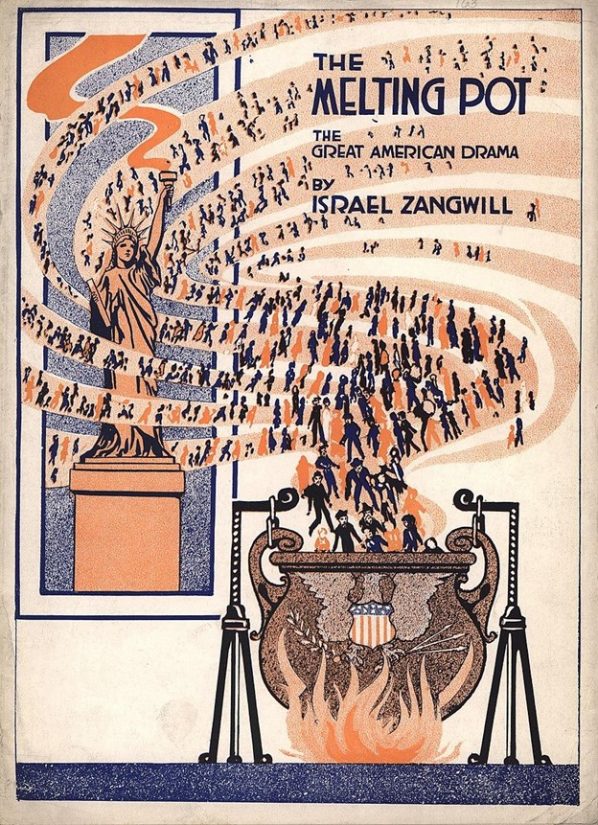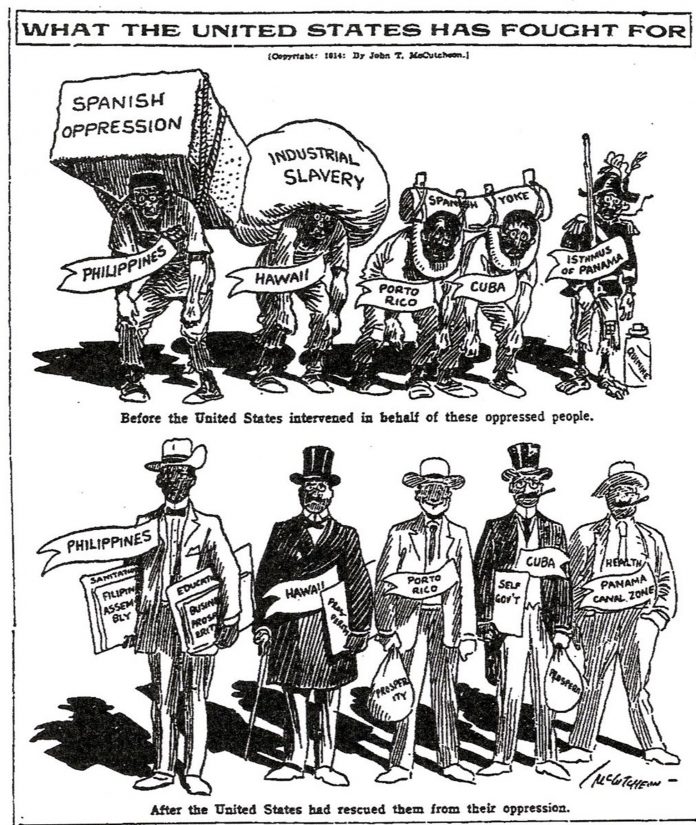Through a White Colonial Lens: A Look into the US Education System
What is taught in American public schools? Or more importantly, what is not taught in American public schools and why are these topics left out?
Throughout my own education and that of others raised in the U.S., American history has been taught from a white perspective, a reflection of this country’s extensive white colonial past. Not only does this narrative provide an extremely narrow perspective of the world, but it also completely ignores the stories and knowledge of Black, Indigenous, and People of Color (BIPOC) communities. The white colonial perspective idolizes historical figures like Christopher Columbus and former president Theodore Roosevelt while painting Indigenous peoples in an unfavorable light, implying that they “live in the past” or are inferior to white peoples. As a result, students that have gone through the American education system often have limited (if any) understandings of topics like colonialism, imperialism, Indigenous Knowledge, and critical race theory.

Photo credit: Janneman, available under U.S. public domain.
The U.S. was founded upon the dispossession of Indigenous lands through settler colonialism and this dispossession continues today. “No U.S. institution would exist…[if it were not for] the original and ongoing occupation of Indigenous lands.” In fact, the first higher education institutions were part of Christian expansionism and much of today’s higher education neglects to address the role of colonization in education itself.
The History of the Imperial American Empire
The history of the U.S. is a history of settler colonialism. Settler colonialism, by definition, involves the acquisition of land and replacement of Indigenous peoples by settlers. Crucially, it is an ongoing structure, not just an event of the past. Settler colonialism continues to impact society today through the racism, inequities, and injustices faced by the peoples whose lands were stolen. Imperialism, on the other hand, involves an empire or nation extending authority over another nation, thereby making them colonies or territories. While imperialism is taught within the U.S. education system, it primarily comes from a perspective that ignores past and current transgressions of the U.S. empire.
The U.S. has an extensive history of colonialism and imperialism inextricably tied to its economic, military, and cultural influence. However, the turning point for American imperial engagements is marked by the Spanish-American and Philippine-American Wars, which ranged from 1898 to 1902. These wars made clear the imperialistic nature of the U.S. The U.S. claims to have “freed” the Philippines from imperialist Spain only to purchase and colonize the islands under the guise of protecting freedom and democracy. After this point, the United States became increasingly involved in international politics and affairs, inserting itself into discussions and conflicts as the “protector of democracy.”
This period catalyzed colonial and imperial activities in Hawai’i, the Philippines, Guam, and Puerto Rico at the hands of the U.S. These histories are not taught in many American primary and secondary schools (or even in higher education). Instead, negative impacts of colonialism and imperialism driven by the U.S. empire are often brushed over in classes. American education portrays the U.S. as the protector of freedom and democracy, rescuing other peoples from imperialist nations, restrictions on freedom, and communism. Themes like Manifest Destiny, as illustrated in John Gast’s American Progress, are seen as historical events that happened for the good of the American people. “Discoveries” by explorers like Christopher Columbus are introduced to students as great feats for Western science and expansion, painting settlers as “saviors” who are rescuing peoples from oppression. Celebrations of these “discoveries” silences narratives of Indigenous dispossession and ultimately serve as a reflection of the U.S. as a whole – forever synonymous with “empire.”

Photo credit: John T. McCutcheon, available under U.S. public domain.
Asters and Goldenrod* (*Western Science and Indigenous Knowledge)
Settler histories are reinforced by a colonial education system. The U.S. public education system continues to center Western concepts and ideals. Histories are presented from a Eurocentric point-of-view, failing to acknowledge the perspectives of other communities or provide culturally appropriate education for BIPOC students. A majority of graduate programs in the U.S., for example, center around the white, Christian, capitalist hegemony.
For instance, through a white colonial lens, Western science is prioritized while Indigenous Knowledge is not included. Western science primarily measures theoretical knowledge rather than practical or hands-on knowledge, placing an emphasis on data, numbers, evidence, and peer-reviewed publications behind paywalls. This form of knowledge tends to be based on paper-and-pencil assessments, while competency is determined by individual knowledge. Indigenous Knowledge incorporates the relationship between humans and the environment. It reaches one step further than Western science, seeking to understand the connections rather than the divides. According to the Indigenous perspective, capabilities are linked to one’s ability to survive and knowledge has a direct relationship with the community rather than focusing solely on the individual.
Today’s schooling reflects the view that Indigenous Knowledge is the opposite of Western science. To date, only Washington and Montana require K-12 curriculum created by Indigenous peoples. Instead, we should be thinking about the coexistence and complementarity of Western science and Indigenous Knowledge. The U.S. education system needs to become more inclusive in order to address equity concerns. Indigenous ways of knowing must be centered in the classroom, perhaps by practicing storytelling or talanoa styles of learning. Such styles of learning allow teachers to take a step back, opening the floor for students to facilitate a dialogue. Through these practices, the power imbalance between student and teacher is minimized.
Localizing knowledge and learning is another way for students to relate their studies to their local environment. In my personal experience, inviting guest speakers to share their experience or ways of knowing through storytelling has greatly contributed to my learning as a graduate student. One of my professors, Dr. Holly Barker, has prioritized Indigenous and localized knowledge by inviting many Indigenous speakers to our classes to discuss their expertise or tell their story. This has led to productive student-led discussions in the classroom, often using the talanoa dialogue structure. If Indigenous Knowledge is making such a great impact on university students, imagine how that knowledge and experience could shape the minds of younger generations throughout their education. Furthermore, it is important to acknowledge the relationship between knowledge generation and power. The people who tell the stories are those who have the most power. Consequently, their voices ultimately drive the formation of knowledge. Incorporating Indigenous ways of knowing and prioritizing the voices of BIPOC and marginalized communities is just one step in addressing power imbalances and decolonizing the U.S. education system.

Photo credit: Diana Ludwig, shared under a Creative Commons license.
(Lack of) Discussion of Race in the Classroom
Over the past few months another issue has arisen in the classroom, drawing attention to how information is presented to students. Critical race theory, or CRT, is an approach that explores race as a social construct. Racism is not a product of individual bias or prejudice; instead, it is deeply embedded within U.S. institutions, legal systems, and policies. Historical redlining and the segregation of neighborhoods is only one example of deeply embedded racism in American society. Critical race theory can shed light on past and current inequities, emphasizing that race issues are not a “relic of the past”; they are embedded throughout today’s society. Critical race theory also seeks to expose the consequences of racism in a society that believes race is no longer a problem. Racism continues to create an “uneven playing field” for nonwhite Americans.
Critical race theory has become controversial and widely misunderstood in the rapidly politicized world, with many conservatives denouncing curriculum and policies that encourage the “liberal agenda.” For example, in December 2021 Florida Governor Ron DeSantis banned the teaching of critical race theory in Florida schools through the “Stop Woke Act.” Not only did this bill allow for parents to sue local school districts for teaching critical race theory, but it also fundamentally upholds white supremacy. DeSantis referred to critical race theory as a form of “harassment” that creates a “hostile work environment” and forces students to learn sensitivity and racial awareness. After claiming that critical race theory was “corporate-sanctioned racism,” DeSantis stated, “How is it not a hostile work environment to be attacking people based on their race, or telling them that they are privileged or that they’re part of oppressive systems, when all they’re doing is showing up to work and trying to earn a living?” Such rhetoric illustrates the essential need for further discussions and education about race, white supremacy, and the legacy of colonialism in America.
Moving Forward
Learning about history and other social sciences inevitably requires discussions about historical instances of racism, imperialism, and settler colonialism. Teaching these subjects in schools would allow students to think critically about the historical impacts of racial inequalities that continue to exist in today’s society. While these concepts are primarily taught in university-level courses, more spaces need to be made to acknowledge systemic issues that revolve around race and inequity.
But it should not be solely taught from a white perspective, thereby whitewashing history. We need to present counternarratives to the dominant Eurocentric, Western perspective presented within the American education system.
It is important to always think critically and question what we are taught. Who decides the narratives in which we are taught? What knowledge or information is left out? In doing so we can decenter the dominant white colonial lens that has dominated the U.S. education system.
Contact Currents’ Editor-in-Chief for access to:
Adams, M. A. (2017). Deconstructing systems of bias in the museum field using critical race theory. Journal of Museum Education, 42(3), 290-295.
Garcia-Olp, M., Nelson, C., Hinzo, A., & Young, D. A. (2020). Indigenous Epistemologies: Implementing Indigenous Practices and Perceptions to the Area of STEM. Curriculum & Teaching Dialogue, 22.
Teranishi, R. T., Nguyen, B. M. D., Alcantar, C. M., & Curammeng, E. R. (Eds.). (2020). Measuring race: why disaggregating data matters for addressing educational inequality. Teachers College Press.